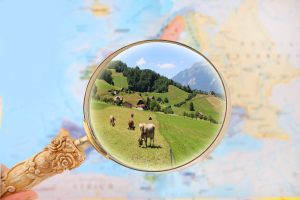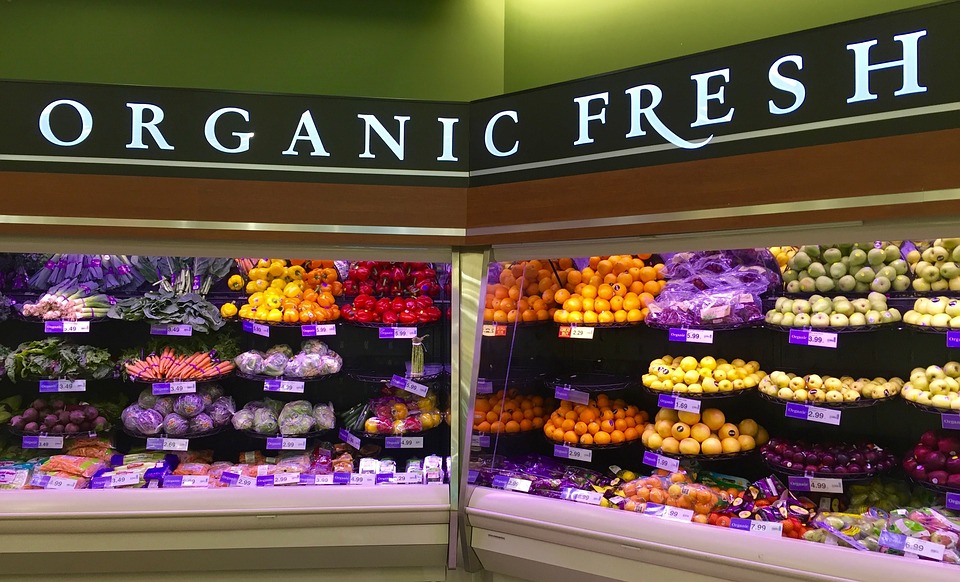Part II described “What is Driving the Growth in Organic Apple Production in WA State?”
Part I presented the basic facts regarding organic apple industry growth in the state, in a blog entitled “Part I: A Tipping Point for Organic Apples in the Pacific Northwest?”
It is a badly kept secret in Washington, D.C. that the USDA , and the U.S. government as a whole, does more to slow the growth in organic farming than support it.
There are several ways that the USDA, other government agencies, and the Congress bring about this unfortunate outcome.
#1 Denial of Consumer Health Benefits
The most consequential USDA policy undermining growth in organic food demand, and hence private investments in the organic food industry and transition at the farm level, is a formerly accurate, and largely innocuous policy statement adopted some 20 years ago –
Organic farming is associated with some environmental benefits, but there are no food safety or nutritional differences between organic food and food from farms under conventional management.
The first part of USDA’s aging, boilerplate-policy statement on the benefits of organic food and farming is consistent with the USDA’s pledge to ground all policies, statements, and programs on sound science, but today, the latter half no longer is.
The list of proven food safety and nutritional benefits of organic food and farming is now impressive, and the science supporting such benefits is deep, wide, and indisputable, except to those people (and there are many) who would rather fight than switch.
This does not mean that every certified organic food product in the market, or served at a restaurant, is safer and more nutritious than the conventionally grown, processed, and prepared food that is also available.
But on average, across the organic and conventional food options accessible in any given market, on the majority of days, organic options deliver tangible food safety, nutritional, and other benefits for consumers.
These benefits range from modest to highly significant, and collectively will support incremental progress in achieving a variety of personal, and public health goals. These include:
- Healthy pregnancies and fewer adverse birth and developmental effects;
- More nutrients per serving, and per calorie consumed;
- Elimination of animal agriculture’s now sizable contribution to the emergence and spread of antibiotic-resistant bacteria;
- Stabilization of pest management systems, some of which are spinning out of control on conventional farms because of the spread of resistant organisms;
- Larger reductions in the number of pesticide residues in food, and near-elimination of pesticide dietary risks;
- Avoidance of any problems, known or as yet unrecognized, triggered by the consumption of genetically engineered (GE) crops, or food ingredients derived from GE crops; and
- Deeper, more unique flavors, and enhanced organoleptic quality.

Scientists worldwide, most scientific organizations, and many governments now accept and acknowledge most, if not all of these benefits. More are bound to do so, as the body of peer-reviewed studies expands, shedding further light on one of more of the above categories of benefits.
Dozens of items on Hygeia Analytics provide an on-ramp to the global science supporting the existence of such benefits, and in some cases, quantifying them (e.g., nutrition, pesticides, antibiotics, the fat profile in milk, childhood development, farmworker safety, soil quality).
Other studies report clear-cut environmental, and animal health and welfare benefits, some of which matter a lot to certain segments of the public.
A second, major cluster of policies holding back growth in the consumer demand for organic food is likewise grounded in denial.
#2 Failure to Acknowledge, Quantify, and Mitigate the Adverse Public Health Impacts of Certain Conventional Food and Farming Practices and Technologies
It is painful to watch respected government scientists, and agencies with core science missions, bend more to the political winds than in response to widely accepted, published science.
After nearly 50 years of progressively more compelling science, the CDC, NIH, and FDA begrudgingly acknowledged a few years ago, in hushed tones and a low voice, that the use of antibiotics on hog, poultry, milk, and beef cattle farms has contributed to the emergence and spread of antibiotic-resistant bacteria that complicate treatment of human, infectious disease.
European scientists, public health agencies, and political leaders reached and accepted the same conclusion 20 years earlier, and now have a 20-year head start in addressing the problem.
This is why, in some European countries, penicillin, tetracycline, and some other, old antibiotics are actually becoming effective again for the treatment of bacteria that had become resistant to them many years ago.
It is also why the next global pandemic of infectious disease will pose less of a threat to citizens in Europe, than to the U.S. population.
Our government still insists, if pressed, that there are no public health differences between an apple or sweet pepper with 10 pesticide residues on or in it, compared to an apple or sweet pepper with none.
A majority of the drinking water in rural areas of the U.S., and essentially all of the Midwest, contains multiple nutrients, pesticides, and other farm chemicals with roots on the farm.
Scientists have struggled for years in an attempt to figure out how to translate exposures to such complex mixtures of contaminants, into estimates of increased morbidity and mortality. This goal remains elusive.
But the underlying problems, and associated health risks, are not standing still. They are growing more serious, and will not wait for science to catch up.

The greatest public health threats facing the baby-boomers are grounded in the metabolic syndrome – overweight and obesity, diabetes, inflammation, cognitive decline, and certain cancers.
Credible science has shown that healthy dietary patterns, coupled with nutrient dense, mostly whole foods not laden with added sugar, fat, and salt, can be as, and sometimes are even more effective than standard medication-based therapies in slowing the progression of disease.
And for people that change lifestyle factors and food choices after the first signs of trouble, and stick with them, incremental erosion in health can actually be reversed. Yes indeed, food can be your medicine, if given a chance.
People who follow doctor-recommended dietary patterns and choose organic brands when available, are further tipping their odds toward better health.
Yet this path to better health remains largely unknown to most people. Those people who have heard about such benefits and paid attention to them, have also no doubt been exposed to many well-spun denials of the connections between organic food and improved health outcomes.
Often, such denials are backed up by official-sounding statements like…”according to the USDA (or FDA, and now even the EPA)”, or “according to a research study done at X university (often by scientists supported by corporate or other special interests).”
These sorts of messages are not driven by science, and are often divorced from it. Delivering such messages is a policy choice, typically arising from political realities impacting the mission, budgets, and freedom to operate within government agencies and universities. This is especially the case in the USDA and publicly funded, land-grant universities, most of which are largely beholden to the conventional ag community, and agribusiness, for state and federal funding, and the next rung on career ladders.
#3. How public dollars are spent.

Most USDA spending that supports farm income is biased against organic farming in a myriad of ways, and only a drop in the bucket is targeted to support the transition to organic, and growth in organically managed acreage.
Several USDA hunger, nutrition, and supplemental feeding programs, including those stimulating exports, are designed to enhance the profitability of conventional crop production, food processing, and food manufacturing.
The few programs that target and strive to support organic food and farming either have one hand tied behind the back, or are implemented to assure one step forward, two steps back.
Minor progress was made in the last farmbill to get both hands and arms pulling in the same direction, and hope runs eternal that the next farmbill will turn baby steps into at least small strides.
But given the way Washington D.C. is functioning these days, and our sobering fiscal math, the big battles in the next farmbill will mostly be over which crops and regions, which sets of stakeholders and programs, will be cut the most, versus those that will just be cut a lot.
There is strong, bipartisan support in Congress for new investments in organic farming methods and systems, but essentially no support for even meager research investments designed to identify and quantify the consumer health benefits of organic food and farming. And the reason is clear.
Why should the USDA, or any other government science agency, invest in research on the consumer health benefits of organic food and farming when the government has proclaimed none exist?
Fortunately, the USDA’s head-in-the-sand attitude about investing in research on organic food and farming benefits is contained largely within our 50 states.
The EU, and most national governments in Europe, have and continue to actively support research on the benefits of organic food production and consumption.
Substantial, cutting-edge research has been carried out on how organic food and farming benefits the environment, biodiversity, animal welfare, and the nutritional quality of foods.
Dr. Carlo Leifert is a colleague who ran for several years Europe’s largest, EU-funded, multi-year project on organic food and farming. Carlo and his research teams have conducted more research on the health benefits of organic over the last 20 years than all scientists in the U.S. combined.
Carlo’s teams have authored several peer-reviewed papers published in high-impact journals, reporting the results of research done by mostly EU-based and financed teams of scientists (see, in particular, seminal papers on the nutritional advantages of plant-based foods, meat, and dairy products).
Carlo estimates that:
“The European Commission alone has spent over 100 Million Euro on organic farming focused R&D programs in recent years. Individual countries have invested millions more. Also, organic farming conversion subsidies are well financed in most EU countries, and designed to stimulate an expansion of the organic sector by lowering the cost and increasing the quality of organic food.”
Public Support for Organic Food and Farming Around the World

EU governing bodies have supported organic agriculture through various programs and policies since 1992. Support takes many different forms, and benefits from several creative policy instruments.
One is direct payments for farmers to transition to organic, often justified by the increase in associated ecosystem services.
Organic regulations in the EU explicitly protect animal health and welfare, which are considered key public benefits associated with organic farming systems.
The Common Agricultural Policy (CAP) has steadily moved away from production incentives and price support subsidies, and toward “multifunctional benefits,” including farm worker and human health.
During the 2018 farmbill debate in the U.S. Congress, such re-direction of commodity subsidies will get talked about some, and earn a little ink, but at the end of the legislative process, the pressure to cut spending will leave most innovative policy proposals on the cutting room floor.
The 2014 CAP has budgeted over €100 billion to invest in the EU’s rural areas through 2020, to help farming meet the challenges of soil and water quality, biodiversity and climate change.
At least 30% of this spending will target environmentally friendly programs, including support for organic farming.
Organic farmers are considered in the CAP to be “green by definition.”
Organic certification automatically makes them eligible for government support payments, while non-organic farmers are required to demonstrate that they qualify, and the requirements are rigorous and far from just a paper-pushing exercise.
A key component of EU formula funding is “area support payments” paid directly to farmers for land that is managed organically.
Member states need to match EU contributions, and are granted some discretion in how the program is administered.
The funds can be spent on financial assistance for farmers during the transition period, maintenance and improvement of ecosystem services, or building the capacity to market organic food to meet local and EU demand.
The average payment is currently estimated to be about $108 per acre eligible for the program, and payments are provided to all qualifying acres that apply for such aid.
No such program providing anywhere near this level of support exists in the U.S.
Another important element of public support in the EU is the Organic Action Plan. It consists of 18 items that the European Commission will take to grow the market and increase organic food production and consumption.
These include measuring consumer awareness of the benefits of organic food, removal of barriers of entry to organic food in the marketplace, green procurement programs, anti-fraud initiatives, research and innovation, and work with trading partners to harmonize international standards.
Each member state is expected to develop its own, more detailed action plan. Some member states are more aggressive than others, and are establishing specific targets for land converted to organic production.
Action plans may include:
- Covering some, or all administrative costs of organic certification;
- Collection and dissemination of organic market data;
- Support for investment in capacity for organic value-added products;
- Promotion and marketing of organic food, including exports;
- Procurement specifications for institutions to purchase from organic sources;
- Research, development, technology transfer and extension;
- Taxes on inputs that are prohibited or restricted in organic production; and
- Increased regulation of non-organic inputs, such as fertilizers, pesticide, and animal drugs.
In 1987, Denmark became the first EU country to set policies that specifically supported organic transition, and the marketing of organic food.
Denmark’s organic certification program is run by the government at no charge to certified organic operators. The program is funded by a tax on pesticides. Sweden also taxes pesticides, and uses some of the revenue to support organic transition.
Denmark, Sweden and Spain all have introduced programs that give priority to organic sources of food in school lunch programs.
About 20% of the food served in Sweden’s school lunches is organically produced. The program in Spain favoring organic sources is currently limited to kindergarten students, a time when exposure pesticides can still disrupt the developing nervous system and brain.

Switzerland and Norway are not part of the CAP, but have programs that provide incentives for farmers to transition, comparable to the programs within the CAP.
Switzerland restructured their production subsidies for national food self-sufficiency in the 1990s, and required farmers to meet ecological standards to qualify for direct payments.
One outcome is that Switzerland has one of the highest percentages of land in organic production in the world.
Norway has provided direct payments to organic farmers since 1990, and has implemented an action plan that targeted 15% of arable land to be in organic production by 2020, proportionally about seven-times more than in the U.S. today.
By a wide margin, the European Union spends the most on organic agriculture research in the world. The estimated $180 million annual expenditure invested in EU organic farming research is roughly triple combined U.S. and Canada investments.
In relative terms, that’s $5.45 out of every $1,000 spent on organic food by European consumers. By contrast, North America invests about $1.40 out of every $1,000 spent on organic food in organic farming research.
In addition to research, the EU makes public investments in extension services and technology transfer that benefits organic production and organic food companies, both large and small.
One initiative is a technology platform for the organic sector. This public-private partnership is managed to strengthen research and innovation in organic and other agroecological farming systems. The entire value chain is involved, and helps policymakers set research priorities.
Some large food companies in the U.S., and especially General Mills, are attempting to do the same thing, but such companies and their partners generally have to swim upstream, whereas all, or most lights are green in the EU.
And the list goes on around the world, with many more creative, well-funded policy and R+D initiatives unfolding on nearly every continent, except ours.
Note: Thanks to Carlo Liefert and Brian Baker for help in compiling policies and investments supportive of organic in the EU.

